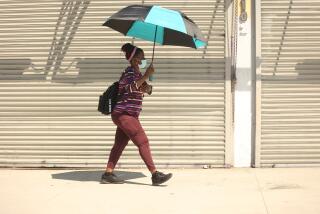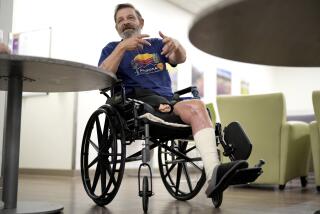Sun Warnings Just Hot Air for Some : Beach-Goers Shrug at UV Danger
- Share via
Four minutes. That was all it took Wednesday for a fair-skinned person to get sunburned, without protection, according to the weather gurus who invented this quirky sun gauge called the ultraviolet index.
By 1 p.m., the index had topped a very high exposure level of 11, as it is expected to do again today. Those without hats, sunglasses and heavy-duty sun block could be in serious danger, if you listened to the experts. But Stacy Cobb didn’t care.
Leaning back on her towel on Santa Monica Beach, the 26-year-old Playa del Rey woman rubbed her bronzed stomach with a clear, low-SPF tanning oil--”a total sun intensifier,” she explained, turning her head up to the hazy sky. “This is what I figure,” Cobb said. “You’ve only got one life to live. Might as well look good.”
And so it went, as the sun worshipers basked on the beach at noon, when the rays were at their worst. For several days in a row, the ultraviolet index (ranging from 0 to 15) had topped 10, entering the danger zone. It has been a year since the Environmental Protection Agency and the National Weather Service started issuing reports on the sun’s radiation levels, and still their warnings are blissfully ignored.
“I’m aware of this phenomenon,” said Drusilla Hufford, a branch chief at the EPA who helped develop the index. “For one thing, there is still tremendous pressure put on being tan. It is very hard to resist. . . . But we’re hoping people will make use of the index and take precautions. If they ignore it, they should understand there are costs associated with it.”
This is how it works: Using data from a satellite, the National Weather Service in Washington calculates the ozone layer, the directness of the sun’s rays to the Earth, regional altitude and cloud cover to determine how much ultraviolet radiation will reach the Earth’s surface in a particular place during the peak hour of sunlight around noon. Their calculations--which are usually higher in late spring and summer--are done a day ahead of time and broadcast along with weather reports.
Still in the experimental phase in 58 cities, the index interprets the ultraviolet radiation level in terms of the number of minutes it would take an average fair-skinned person to burn without protection.
At the low end, a reading of 0-2 indicates a minimal exposure level; very fair-skinned people could become sunburned in 30 minutes. At the high end, an exposure level of 10 or greater means that the same person could suffer sunburn in about four minutes.
Los Angeles County lifeguard Doug Guerra-Trinidad has olive-colored skin, but he said he doesn’t take any chances. On Wednesday, he covered himself in an SPF 40 sun block before taking to the beach for the afternoon shift. Better safe than sorry, he figures.
“I use it every day,” he said.
Casey Coleman and her mother, Chris, both of McLean, Va., also took precautions in anticipation of the dangerous UV rays. The Colemans, who are vacationing in Santa Monica, brought three types of sun block--SPF 30, 15 and 4--to the beach.
“In the last few years, I’ve been taking more precautions,” said Chris McLean. “The sun is less kind than it used to be, as if it were ever kind.”
But others were unrepentant. Although they knew that exposure to the sun can cause wrinkles and skin cancer, they just didn’t care.
“I confess,” said Jennifer Morgan, 26, sitting cross-legged on a beach towel and smoking a cigarette. “I come out three times a week. I just use straight moisturizer.”
And a man named Kevin, who asked that his last name not be used, put it this way: “I’m 47 years old. Seventy-five percent of my life is over. So I’m just going to enjoy myself.”
(BEGIN TEXT OF INFOBOX / INFOGRAPHIC)
Sunburn Watch Ultraviolet radiation rankings indicate what the exposure is expected to be at noon, when the sun’s rays are strongest. *
What is UV: Potentially harmful rays from the sun. *
The Problem: Ultraviolet radiation is blamed for a host of health problems, includingskin cancer and cataracts. *
Reading the Rays: Using data from a satellite, the weather service calculates the ozone layer, cloud cover, altitude and proximity of the sun’s rays to determine the UV figure. *
Prevention Stay out of sun between 10 a.m. and 3 p.m. *
Use a waterproof sunscreen with an SPF of 15 or higher; and one that protects against UV- A and UV- B rays. *
Sunburns received from infancy to teen years can increase the risk of contracting melanoma as an adult. *
Ultraviolet radiation is strong on relatively cool days and can penetrate clouds. *
Ranking: 0-2 Exposure level: minimal Fair- skinned people could suffer sunburn in: 30 minutes, unless properly protected *
Ranking: 3-4 Exposure level: low Fair- skinned people could suffer sunburn in: 15-20 minutes *
Ranking: 5-6 Exposure level: moderate Fair- skinned people could suffer sunburn in: 10-12 minutes *
Ranking: 7-9 Exposure level: high Fair- skinned people could suffer sunburn in: 7-8 minutes *
Ranking: 10 or more Exposure level: very high Fair- skinned people could suffer sunburn in: about 4 minutes Sources: National Weather Service, AP, Times files
More to Read
Sign up for Essential California
The most important California stories and recommendations in your inbox every morning.
You may occasionally receive promotional content from the Los Angeles Times.










